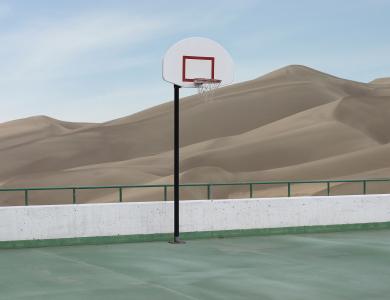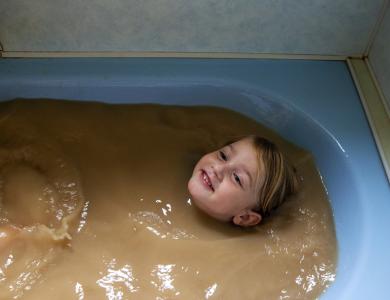
Catherine Hyland is a London-based photographer who studied at Chelsea School of Art and the Royal College of Art. Through her work, she looks at the relationship between humans and their environment through a strong documentary approach.
Catherine takes over our Instagram for This Week’s Focus, where she’ll be sharing her series The Traces Left Behind, which looks at the North Korean immigrant community living in the south London suburb New Malden.
What are you trying to communicate through your work, most notably in your series The Traces Left Behind?
My work often looks at the idea of negotiating borders and looking at space and place from a theoretical sense. The two different aspects of the human/landscape relationship. It is never personal to me, my memories, it's specific to that culture and country. Also combined with my interest in leisure sites as a perfect case study for the way we interact and what we can learn from humanity when looking at what is initially perceived as trivial.
The human dimension of the landscape has always been important to me but it has become increasingly interesting recently while I am focusing more on the environmental factors we are currently facing, advances in technology and the effect that has on the people and the land. So I'm looking at the important use of landscape as a physical space for living and working, but also as a place with it's meanings and contributions to societal identity. Not focusing on my identity but the identity of that country and their history. Through that however I'm also reflecting on my place in the world and my understanding but that isn't something I focus on with the work, more a reason behind why I make the work and what fuels me to do so. It's through landscape perceived as place that I look at the concepts of sense of place and place identity. In this case it’s London which I haven’t looked at before, I’m not usually making work about my home.
This project is looking more at place-related behavioural rules and how they are being transferred. It’s also focusing on movement and the healing power of movement. The people in these photographs connect through dance. By performing in front of each other they are putting themselves in a vulnerable position but they are so enthusiastic which creates a really positive space. Supporting the idea that people know how to act within their environment in a secure way and thus build up a personal relationship to it. I’m becoming more interested in mental map studies within this project and the notion that borders support people’s efforts to establish a clear representation of their places.
New Malden is home to the biggest community of North Koreans outside of the Korean Peninsula. Defectors live complicated lives, traversing the gulf between then and now. People defect for political, ideological, religious and economic reasons. The brutality of the regime is impossible to imagine, starvation, propaganda and political pressure and punishments are just some of the extreme problems they face on a daily basis. Everything is decided for you. Free will does not exist. The psychological and cultural adjustment can be hard due to the extreme conditions they are used to. Health problems range from Post Traumatic Stress Disorder to issues caused by long-term malnutrition. Many defectors talk of feeling like ‘a stranger in a strange land’. Experiencing such prolonged and significant trauma can make the transition to a new country extremely tough. The concept of freedom is difficult to comprehend after decades of repression.
When I embarked on this project I knew I would be meeting particularly resilient people but I hadn't expected to be witness to their sheer determination to celebrate joy. Their commitment to enjoy their lives and find and hold onto happiness is apparent in everything these people are doing and I think that shows such strength and a sense of purpose. It was really touching. I felt like I learned a huge amount from each character. I felt that there was so take from such strong individuals all helping one another. I realised over time that there is a very clear message to be taken from this group, which is that they are all going to support one another in moving forward and no one will be left behind, no matter their age or health or if it in some way held the group back.
One of the ladies discusses this in her interview. She felt bad about holding the group back because she feels so old and can’t move in the same way as the younger members. But she couldn’t give it up because it brings her so much happiness. The group is about patience and caring for one another. I'm sure they gossip and get frustrated, but they think as a whole.
I think a lot of the problems we have in modern society is about people thinking in individualistic terms. I've learned so much from the community but in particular the incredible older generation. The way they support each other has such impact, building strong, loving bonds between a fractured community in a state of flux.
What brought you to this community of North Koreans in South London? Could you tell us about the research and planning that went into the series?
I contacted a charity called NK Connect in November 2018 with Gem Fletcher, an Art Director who I was collaborating with. They do some exceptional work in and for the community despite having minimal resources. I showed them some of my recent projects and explained that I wanted to create some uplifting art about the community. I was interested in a collaboration that would be beneficial on both ends. This is a long term project for me; much of our time has been spent getting to know different groups within the community, building trust and learning about their experiences. A lot of time was spent together before we even began shooting.
Our biggest challenge was the language barrier. Very few of the community members speak English, so one of the most important parts of the project was working with a translator. We connected with The Korean Senior Citizen Society which is part charity shop run by volunteers and part education centre, conducting all kinds of lessons to help people in the community. It was there where we met some of the incredible older women who had created this traditional dance troupe that practiced their routines in the back of the shop. This was a great starting point, as the ladies love to perform and enjoyed the creative process of being photographed.
Other activities in the programme include learning how to play traditional Korean instruments; being introduced to London’s museums; studying reflexology; practicing English; belonging to a choir; enjoying free haircuts and using laughter therapy to be happy. Everyday they supply a free lunch where the senior members cook for each other. Anyone is welcome to join, and it's a crucial part of their daily rituals as well as being a lifeline for new defectors. Their ages range from around 55 to 94.
After spending some time with them they introduced me to the KPOP dance competitions which were held in the churches in and around New Malden. I started going to the competitions and slowly introducing myself to the community, not shooting just seeing who was interested in speaking to me. I wanted to find out why the groups were so important to them: what were they hoping to get out of it? Is it about connection? Is it a sanctuary for them or something more existential?
I also spoke to the translator who took me around New Malden and introduced me to members of the community that were perhaps more isolated. Surl Lee is an artist (builder by trade) we visited a few times in his studio, which is a garage behind a residential home.
The translator also acted as a fixer; she found a restaurant in the back of a small supermarket that is just a door by the side of a fridge that I would never have found without her. The restaurant is run by a North Korean chef who shared various North Korean dishes with us. So much of the project has been about spending time with the community, listening to their stories and experiencing their incredible culture. They now invite me to events themselves which have been really nice. I've released the Senior Citizen Dance Troupe section of the project, but KPOP will be the next section and then rituals in relation to food and faith in art.
The North Korean community draws considerable attention from the press, but my aim is to focus on much more of an internal understanding of the community and to look at the less tangible elements of a re-established life so far from home. I’m interested in using the collaborative nature of the project to offer a platform for expression, upon which one places a great deal on symbolic meaning, that hopefully moves us into another more informal way of measuring time and experience.
I am a great believer that it is the trivial acts that tell us the most about humanity. From my experience researching the community, it is the simple things such as dance and sharing food that has established a democratic setting whereby everyone is accepted. A safe space for people to express themselves freely, no matter what their background. This has been especially evident at the KPOP competitions, where the children have come from all different walks of life and backgrounds from different countries.
I hoped for the project as a whole to be a vibrant, hypnotic take on our current political climate. Looking at identity and ideological views through rituals that at first, could be dismissed but should most definitely be celebrated. I wanted the series to have a very practical resolve, in that it helps bring together the refugee communities that live alongside one another here in London. It also aims to celebrate cultural heritage whilst looking at the human rights element of individual stories.
I wanted the stories to be told in a more intimate way and show how we use our bodies and movement to digest complex emotions, focusing on the power of the more ethereal aspects these activities sometimes bring out. The aim was to promote acceptance, understanding and camaraderie between the resilient communities that reside in London. It was crucial that this series was about the enjoyment of art and its deeply social dimension, a shared understanding of the way it can deepen our bonds and break down boundaries.
Cultures and stories from across the globe are predominant themes in your work. How do you choose a new subject for a project?
New bodies of work usually start when I have had a visceral response to a certain moment. It’s quite often an emotional reaction to something I have experienced or read. I tend to work quite intuitively and then follow that with a period of extensive research, to help me understand how I can push the parameters of my chosen subject matter. It’s very much about putting the time in. My projects usually end up being quite labour intensive.
I did a project on child Sumo wrestlers in Mongolia which was funded by WeTransfer but the focus, in the end, was on climate change and the extreme conditions they faced living in one of the most polluted cities in the world. And to test their resilience even further, it was very clear they had chosen a sport which the Japanese Sumo Association were keen to keep them out of by limiting the number of foreigners that were allowed to train in the Sumo stables in Japan, so it was also about abuse of power and how red tape is used to try and suppress people no matter how exceptional their abilities are.
Who are your creative influences?
My influences include Julian Rosefeldt – especially the film and video installation work he produces; Matthew Barney’s Cremaster Cycle; Domingo Milella’s landscapes; Bas Princen’s architecture shots; Gillian Wearing; Cai Guo-Qiang; Maurizio Cattelan; Thomas Struth; Elmgreen & Dragset; Taryn Simon; Adrian Ghenie; Giorgio Morandi.
You are represented by ACN, an agency working with female photographers. How has belonging to an agency furthered your practice and career?
I think the main thing for me has been that because ACN is based in New York it’s made my opportunities more varied. For the last few years the majority of my commissioned work has been from America. That’s been a really great experience, it’s opened a lot of doors for me. I enjoy going to New York to meet different clients and picture editors, it feels like my world is expanding in a very positive way.
What have you learned about your photography by using Instagram?
It does have it’s limitations but it is a brilliant tool for connecting with people and getting your work out there. It’s quite a democratic platform that gives people the opportunity to spread their work far and wide without there being gatekeepers. I think that in itself is a brilliant thing.
You were shortlisted in the Sony World Photography Awards 2019 Professional competition Landscape category for your series Lithium Mining. Has the Awards had any positive impact on your career?
Yes in that it made people aware that this was a subject I feel strongly about and I think it probably helped me receive similar commissions further down the line looking at the environmental factors we are facing at present.
You have taken part in many online exhibitions and fundraising events during the lockdown period. What is next for you and your photographic practice?
It’s become increasingly important for me to use my practice in conjunction with charities and to figure out how I can use my practice to benefit society. I think across the world we are seeing people turn to a slightly more holistic approach to life and work, this has always been important to me and something I am putting a great deal of thought into. Figuring out how I can push those boundaries. I’m working on a book at the moment and have the other four chapters of The Traces Left Behind that I am gathering material for, so that is my main focus at present.
Enjoy Catherine's takeover here



